#Nicola Kast
Text
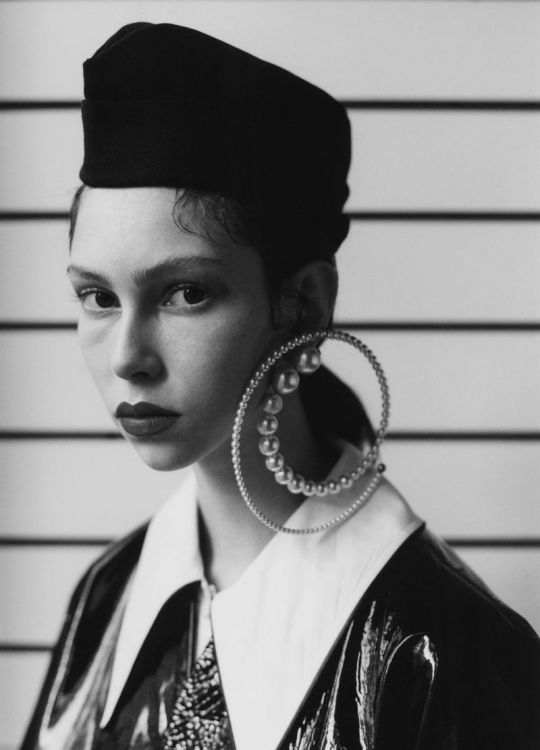
#Office Magazine#Spring/Summer 2018#2018#Thurstan Redding#Anders Solvsten Thomsen#Louis Ghewy#Ciara O'Shea#Nicola Kast#Lorena Maraschi
16 notes
·
View notes
Text

SSAW Autumn Winter 2018-2019. Issue 14.
CHARLOTTE O’DONNELL at Midland photographed in Woodstock (New York) by CHRIS RHODES and styling by SASHA KELLY
Casting Direction by NICOLA KAST
Charlotte wears floral dress by SAINT LAURENT BY ANTHONY VACCARELLO
0 notes
Text
This LATAM player is taking a winless VCT team on an LCQ run for the ages
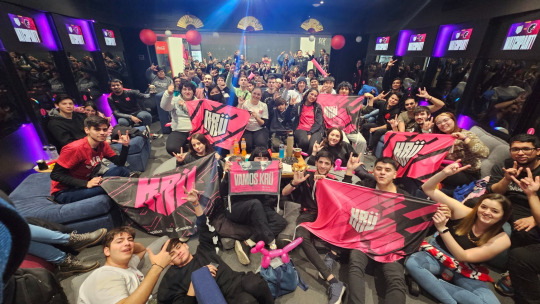
One LATAM player is dominating the Americas tournament despite the fact that his squad didn't record a single victory during the regular season. Every Last Chance Qualifier on the VALORANT Champions Tour has its own unique tale.
KRÜ Esports are once again making an unexpected run, catching fire exactly when they needed to as they battle to qualify for Champions 2023 in Los Angeles. Their star duelist Angelo “keznit” Mori is topping almost all stats thanks to his standout Jett and Raze play, helping the team not only earn their first win in 2023 but blitz through the upper bracket finals with a three-game winning streak.
https://twitter.com/valesports_na/status/1681123296132362240
KRÜ entered the LCQ as the tenth seed, meaning they would potentially have to play the most matches out of all the teams to make it to Champions. It all began with a convincing win against MIBR, closing out both maps without losing more than eight rounds on either. Keznit, alongside longtime teammate Nicolas “Klaus” Ferrari, led the charge in that series. Impressively, keznit was the second-best player in the lobby, which is statistically his worst match of the tournament heading into the upper bracket finals.
In the next series against FURIA, keznit put up some unbelievable numbers in KRÜ’s 2-1 win. Ending the series with 71 kills, 19 more than the next-best in the lobby, keznit showed no sign of slowing down. He would finish with an absurd 29-kill performance on Bind to move forward in the bracket.
On July 17, KRÜ had a chance to upset regional rivals Leviatán to secure their upper bracket future, and once again, keznit rose to the occasion. While it wasn’t nearly as chart-topping a performance as in the FURIA series, he led the lobby in kills for the second time in three games with 44 kills.
After helping the team secure a 2-0 series win and a future matchup against Cloud9, keznit has been the best player of the tournament by raw statistics, and it’s no contest. His aggressive Raze gameplay has him leading in first bloods, and his top-tier aim with the Vandal makes him nigh unstoppable to his foes.
So far, keznit is number one in match rating at 1.46 and ACS at 306.4 according to VALORANT stats site vlr.gg. On top of that, he’s first in KAST at 84 percent, K/D at 1.56, and damage per round at 198.5. He’s also proving himself a valuable end-of-round figurehead with a 36 percent clutch win ratio. He’s both the best player currently in the tournament and the biggest riser. In the regular season, he put up some high stats but couldn’t lead his team to victory. Now, he’s fragging and leading his team to victory, a key staple of KRÜ’s previous runs.
Of course, these stats are subject to change as KRÜ faces Cloud9 next, but KRÜ is prone to runs this like this. They proved they had this sort of form in them at Champions in 2021, eliminating Sentinels and Fnatic. Two years later, the roster has gone from a winless team to one of the hottest teams in the world thanks to keznit’s run in this LCQ.
KRÜ faces off against Cloud9 on July 18, as the second match of the day after Sentinels versus Leviatán.
Read the full article
0 notes
Text
Dior Magazine No. 41 COVER
Dior Magazine No. 41 COVERSource: dior.comPublished: March 2023
All people in this magazine cover:
Julia Hetta – Photographer Hannes Hetta – Fashion Editor/Stylist Tomohiro Ohashi – Hair Stylist Christine Corbel – Makeup Artist Shona Heath – Set Designer Nicola Kast – Casting Director Bente Oort – Model
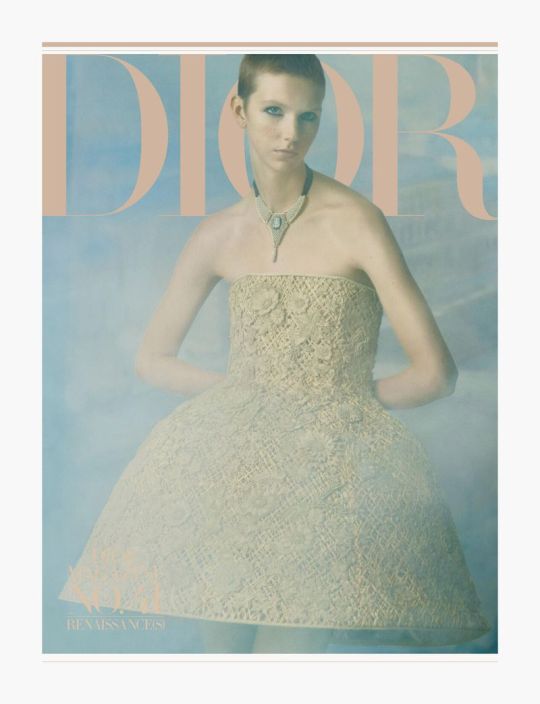
View On WordPress
0 notes
Text

Re-Edition Magazine, September 2019, Laura Jane Coulson Photographer, Vittoria Cerciello Stylist, Nicola Kast Casting Director
45 notes
·
View notes
Photo

Molly Bair by Chad Moore for The Edge Of Glory 10 Magazine Fall/Winter 2018
#chad moore#molly bair#tereza ortiz#nicola kast#fashion editorial#fashion photography#editorial#10 magazine
86 notes
·
View notes
Photo
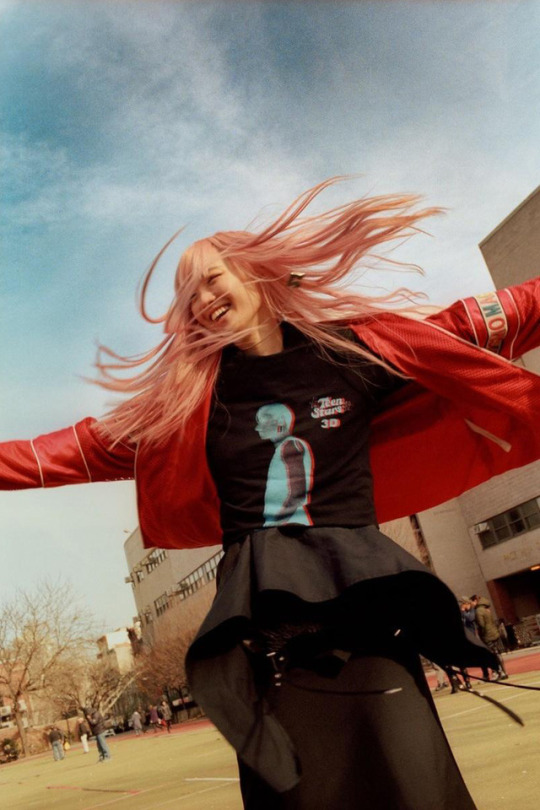
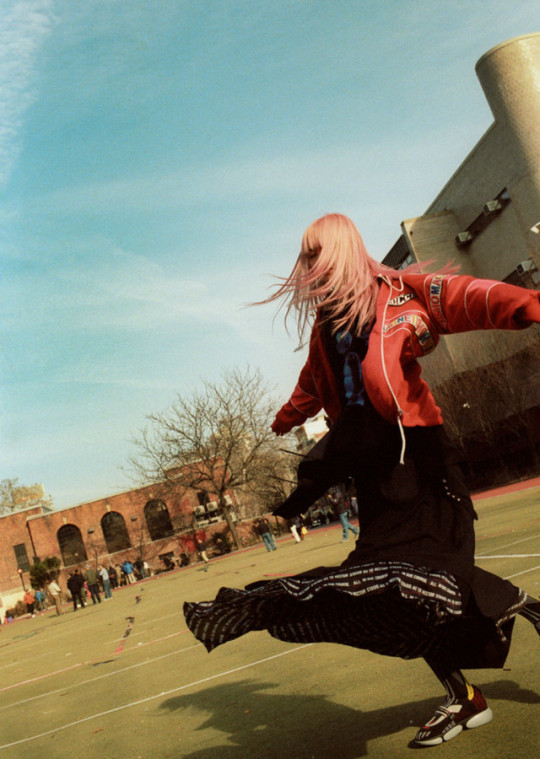








‘Modern Dreamers’
Fernanda Hin Lin Ly for MUSE Magazine — Spring/Summer 2018 Issue #49.
Ph: Chad Moore
Stylist: Ethel Park
Casting director: Nicola Kast
www.musemagazine.it [ Part 1 ]
#利献灵#Fernanda Hin Lin Ly#warukatta#Fashion#MUSE Magazine#Chad Moore#Phtoography#Ethel Park#Nicola Kast
47 notes
·
View notes
Photo

Raf Simons FW17
Photographed by Rob Kulisek
Styled by John Colver
Hair by Tomi Kono
Makeup by Migeul Lledo
Casting by Nicola Kast
AtLarge #9
37 notes
·
View notes
Photo
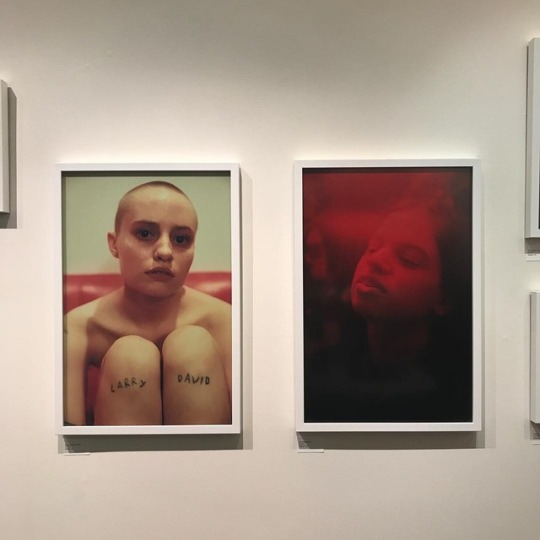
https://www.instagram.com/p/BVLX1prFD7e/
74 notes
·
View notes
Text
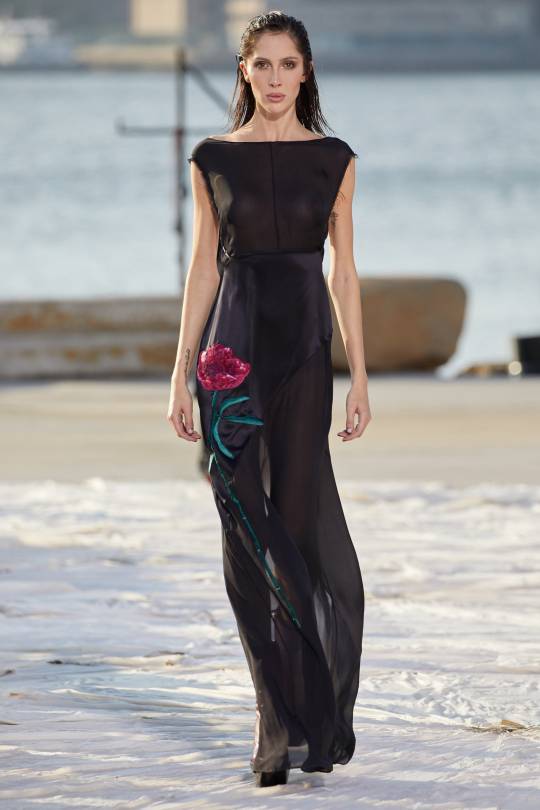
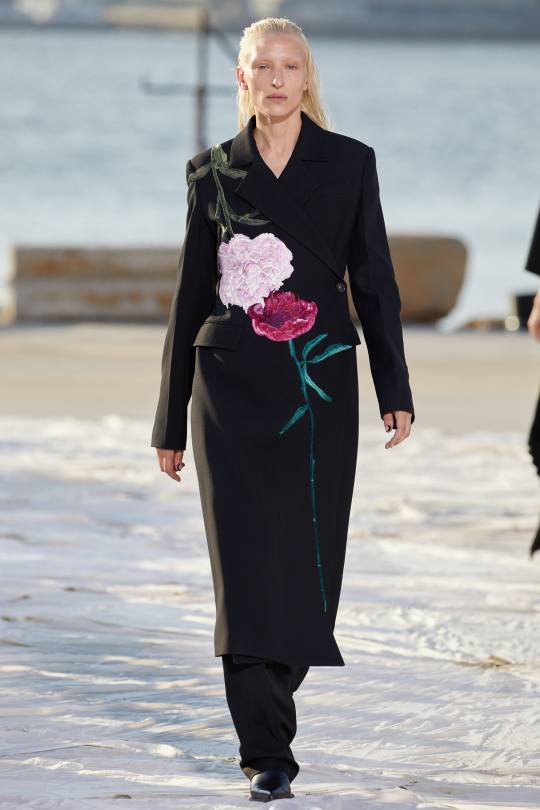
Peter Do Spring/Summer 2022
Mustafa Yanaz - Hair Stylist
Aaron de Mey - Makeup Artist
Nicola Kast - Casting Director
Jin Soon Choi - Manicurist
13 notes
·
View notes
Text
Astronomy photographer of the year contest 2020

Andromeda Galaxy at Arm’s Length?” by Nicolas Lefaudeux (France). Overall Winner and Galaxies, Winner.
Have you ever dreamt of touching a galaxy? This version of the Andromeda Galaxy seems to be at arm’s length among clouds of stars. Unfortunately, this is just an illusion, as the galaxy is still 2 million light-years away. In order to obtain the tilt-shift effect, the photographer 3D-printed a part to hold the camera at an angle at the focus of the telescope. The blur created by the defocus at the edges of the sensor gives this illusion of closeness to Andromeda.
Sky-Watcher Black Diamond 100 mm apochromatic refractor telescope at f/9, iOptron iEQ30 mount, Sony ILCE-7S camera (modified), ISO 2000, 2 hours 30 minutes total exposure.
Now in its 12th year, the Insight Investment Astronomy Photographer of the Year competition continues to impress. With over 5,000 entries from astrophotographers around the world, the level of competition was high. But in the end, French photographer Nicolas Lefaudeux took the home top prize for photographing our neighboring galaxy.
His incredible photo of the Andromeda Galaxy is a creative look at the galaxy that’s closest to our own. The tilt-shift effect makes it look as though it’s within reach when, in reality, it’s actually two million light-years away.
Running from October 23, the exhibition will also feature all of the exceptional runners-up and highly commended images.
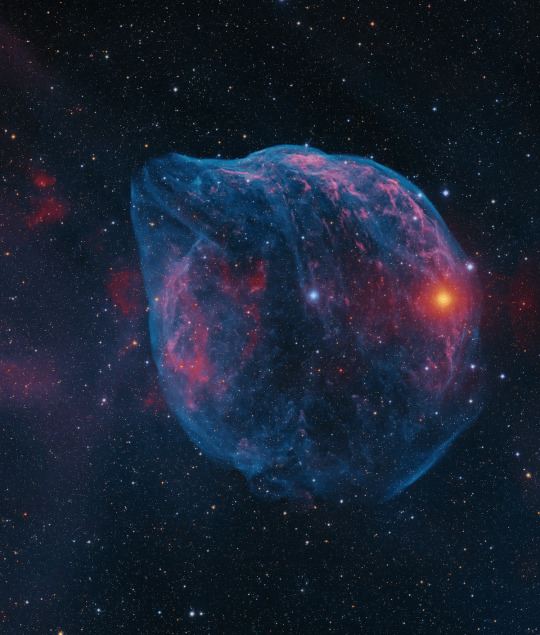
“The Dolphin Jumping out of an Ocean of Gas” by Connor Matherne (USA). Stars & Nebulae, Runner-up.
This target is officially known as Sh2-308, but the photographer has always enjoyed calling it the Dolphin Nebula. It is a bubble of gas being shed by the bright blue star in the center of the image as it enters its pre-supernova phase. The red star to the right could possibly be influencing the shape too and might be responsible for the bill of the dolphin. While it won’t explode in our lifetimes, seeing the warning signs are quite neat. It never hurts to say that the warning signs are the most beautiful part of this particular target!
Takahashi TOA-150B telescope at f/7.3, Astro-Physics 1600 mount, FLI ML16200 camera, RGB-Ha-OIII composite, 33 hours total exposure.

“Painting the Sky” by Thomas Kast (Germany). Skyscapes, Winner.
The photographer was searching for clear skies in Finnish Lapland to capture the beauty of a polar night and couldn’t believe his eyes when he saw what was waiting behind the clouds. Polar stratospheric clouds are something the photographer has been searching for many years and had seen only in photographs until that day. He took his camera onto a frozen river to get a good view and started to take photos. The clouds slowly changed their shape and colors. It was like watching someone painting, especially when the Sun was lower – it started to get a darker orange and the pink shades became stronger.
Nikon D850 camera, 120 mm f/16 lens, ISO 64, 1/40-second exposure.

“Space Between US…” by Łukasz Sujka (Poland). Planets, Comets, and Asteroids, Winner.
This image shows the really close alignment of the Moon and Jupiter that happened on 31 October 2019. In the full resolution picture, you’ll see that there are three of Jupiter’s moons also visible. This small project is a big challenge that involves a lot of luck and good seeing conditions. To capture this phenomenon in such a big scale was quite demanding in data acquisition as Jupiter and the Moon traveled across the sky quite fast. It happened at altitude only 9 degrees above the horizon. I wanted to show the huge emptiness and the size of space, which is why there is a lot of ‘nothing’ between the two major parts of the image.
Sky-Watcher Newtonian 10″ telescope at f/4.8, Baader MPCC Coma Corrector filter, Sky-Watcher NEQ-6 mount, ZWO ASI178 MM-C camera, 300 x 10-millisecond exposures per channel.
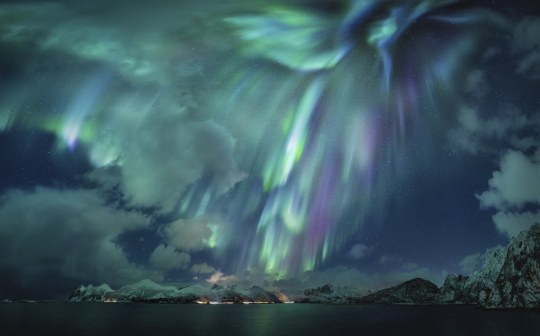
“The Green Lady” by Nicholas Roemmelt (Germany). Aurorae, Winner.
The photographer had heard a lot of stories about the ‘lady in green’. Although he has had the chance to photograph the Northern Lights many times, he had never seen the ‘green lady’ before. On a journey to Norway, she unexpectedly appeared with her magical green clothes making the whole sky burn with green, blue, and pink colors.
Canon EOS R camera, 14 mm f/1.8 lens, ISO 6400, 4 x 1.6-second exposures.
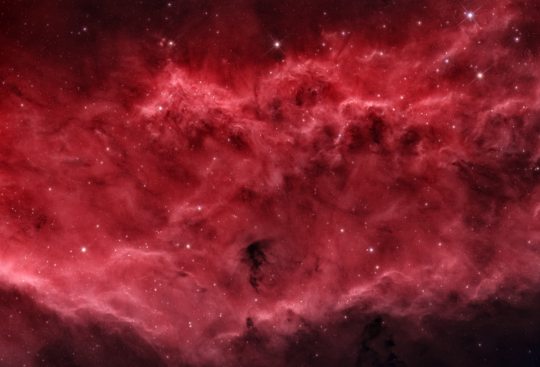
“Waves” by Bence Toth (Hungary). Sir Patrick Moore Prize for Best Newcomer.
The image shows the central region of the California Nebula (NGC 1499). It tries to show the uncontrollable vast energy of nature, in a form which resembles the huge waves of a storm in the ocean. The RGB channels are used the create the colors of the stars, and all of the nebulosity is synthesized from the hydrogen-alpha and the SII channels. The color assignment of the narrowband channels is done in a way to create an image close to true color, but preserving the fine details and the depth provided by the narrowband filters.
Sky-Watcher Quattro 200P telescope at f/4, Sky-Watcher EQ6-R mount, ZWO ASI1600MM Pro camera, RGB-Ha-SII composite, 7 hours 50 minutes total exposure.

“HDR Partial Lunar Eclipse with Clouds” by Ethan Roberts (UK). Our Moon, Runner-up.
During the 2019 partial lunar eclipse, the photographer managed to capture this fantastic image of the Moon while a small cloud passed in front of it. You can see the Earth’s shadow on the top right and its striking orange color caused by the Sun’s light passing through the atmosphere. This is a high dynamic range image, meaning both the darker, shadowed region is correctly exposed as well as the much brighter parts of the Moon. This processing technique also allows the clouds to be seen more clearly, giving the Moon a similar appearance to that of a solar corona.
Sky-Watcher Evostar 80ED telescope, Sky-Watcher EQ5 SynScan mount, Canon EOS 100D camera, 600 mm f/7 lens, ISO 800, composite of 5-second, 1-second, 1/10-second and 1/30-second exposures.
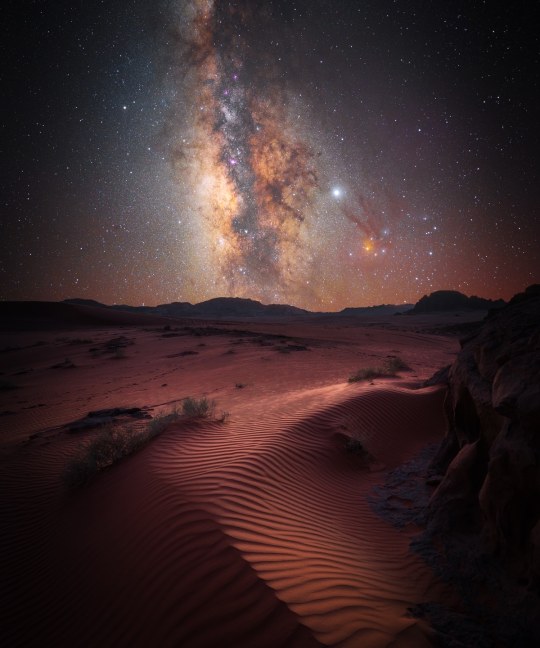
“Desert Magic” by Stefan Leibermann (Germany). Skyscapes, Runner-up.
The photographer took this image during a trip through Jordan. He stayed for three days in the desert at Wadi Rum. During the night, the photographer tried to capture the amazing starry sky over the desert. He used a star tracker device to capture the sky. The photographer found this red dune as a foreground and captured the imposing Milky Way center in the sky.
Sony ILCE 7M3 camera
Sky: 24 mm f/2.4 lens, ISO 1000, 272-second exposure
Foreground: 24 mm f/8 lens, ISO 800, 20-second exposure.

“Cosmic Inferno” by Peter Ward (Australia). Stars & Nebulae, Winner.
NGC 3576 is a well-known nebula in southern skies, but is shown here without any stars. Software reveals just the nebula, which has been mapped into a false color palette. The scene takes on the look of a celestial fire-maelstrom. The image is intended to reflect media images taken in Australia during 2019 and 2020, where massive bushfires caused the destruction of native forests and have claimed over 12 million acres of land. It shows nature can act on vast scales and serves as a stark warning that our planet needs nurturing.
Alluna Optics RC-16 telescope at f/8, 5 nm Ha filter, Paramount ME II mount, SBIG STX-16803 camera, 32 x 10-minute exposures.

“145 Seconds of Darkness” by Filip Ogorzeski (Poland). Our Sun, Runner-up.
This image was captured during the total solar eclipse seen on 2 July 2019. The photographer traveled 13,000 kilometers from Poland to Chile to see the total solar eclipse. His plan was to create the most minimalist picture of this breath-taking event and capture the brief moment when nature freezes; the birds fly to their nests and the temperature drops during 145 seconds of darkness.
Fujifilm X-T2 camera, Carl Zeiss Touit Planar 32 mm f/1.8 lens at f/5.6, ISO 400, 1/90-second exposure.
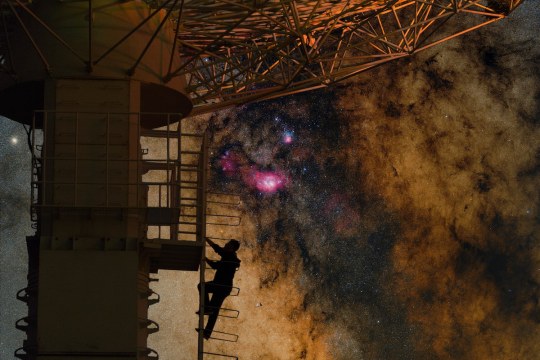
“Observe the Heart of the Galaxy” by Tian Li (China). People and Space, Runner-up.
This image depicts the photographer climbing the radio telescope and Mingantu solar radio telescope array. First, the photographer tested and moved his camera so that the M8 and M20 nebulae would appear right next to the telescope. After taking the foreground image, he moved his camera a little bit but still pointing at the same location in the sky, and captured the background with an equatorial mount.
Sigma 135 mm telescope at f/1.8, Sky-Watcher Adventurer mount, Canon EOS 6D camera (modified), 135 mm f/1.8 lens, ISO 1600
Sky: 15 x 30-second exposures
Foreground: 30-second exposure.
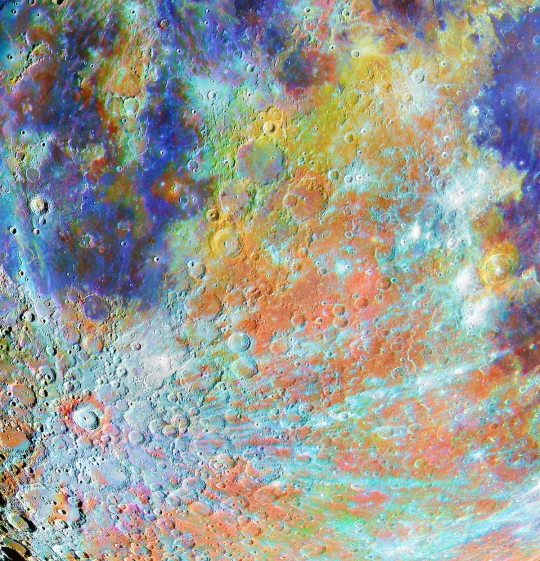
“Tycho Crater Region with Colours” by Alain Paillou (France). Our Moon, Winner.
The Tycho crater is one of the most famous craters on the Moon. This huge impact has left very impressive scars on the Moon’s surface. With the colors of the soils, Tycho is even more impressive. This picture combines one session with a black-and-white camera, to capture the details and sharpness, and one session with a color camera, to capture the colours of the soils. These colors come mainly from metallic oxides in small balls of glass and can give useful information about the Moon’s geology and history. The blue shows a high titanium oxide concentration and the red shows high iron oxide concentration. This picture reveals the incredible beauty and complexity of our natural satellite.
Ceslestron C9.25 telescope at f/10 and f/6.3, Orion Sirius EQ-G mount, ZWO ASI178MM and ASI178MC cameras, multiple 15-millisecond exposures.

“Lone Tree under a Scandinavian Aurora” by Tom Archer (UK). Aurorae, Runner-up.
The photographer decided to explore on foot around the hotel on a very crisp -35°C evening in Finnish Lapland. When he found this tree, he decided to wait for the misty conditions to change and could not believe his luck when the sky cleared and the aurora came out in the perfect spot. The photographer spent about an hour photographing it before his camera started to lock up due to the conditions, but by then he was happy to call it a night.
Nikon D850 camera, 15 mm f/2.8 lens, ISO 1000, 13-second exposure.
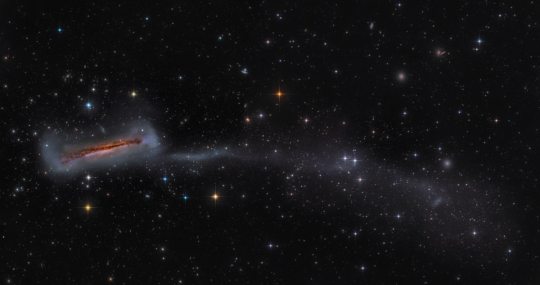
“NGC 3628 with 300,000 Light Year Long Tail” by Mark Hanson (USA).
Galaxies, Runner-up.
NGC 3628 is a popular galaxy target for both astrophotographers and visual observers with its distinctive dust lane. Studies by professional astronomers have shown that the evolution of some galaxies is the product of a series of minor merges with smaller dwarf galaxies. This image is an epic undertaking of five years of exposures taken with three different telescopes, although the majority of the exposure was in 2019. The goal of this ambitious mosaic is to show the tidal tail, measuring 300,000 light years in length, with enough depth combined with a wide field of view to show it in its entirety.
Planewave 17, Planewave 24 and RCOS 14.5 telescopes at f/6.8, Planewave H200 and Paramount ME mounts, SBIG 16803 camera, L-RGB composite, 54 hours total exposure.

“Infrared Saturn” by Julie F Hill (UK). Annie Maunder Prize for Image Innovation.
Dark River is a sculptural work that maps, or mirrors, the Milky Way celestial entity using one of the largest images ever made of its central areas. Referencing Elizabeth Kesseler’s notion of the astronomical sublime, as well as Gaston Bachelard’s idea of ‘intimate immensity’, this gigapixel image of the Milky Way, showing around 84 million stars, is reworked into a sculptural ‘affective space’ that affords a bodily and imaginative engagement with the viewer. The image was obtained with the VISTA survey telescope at ESO’s Paranal Observatory in Chile and contains nearly nine billion pixels. This was an incredibly large file to work so the artist had to cut it down into manageable pieces to then print. She made 2.2 x 1-meter sections, which she then laboriously printed and glued together by hand to create a 9 x 5-meter sheet when flat. The image was digitally printed at 300dpi using archival pigment inks, onto a Japanese paper that is lightweight yet robust. In creating this piece, the artist was emulating the mosaic process used by astronomers when processing and compositing data. The artist retained the naturalistic colors the astronomers used to color the image, which makes the celestial more earthly and relatable. The full-sized print is sculpted to adapt to the space in which it’s displayed.
VISTA Survey Telescope, Infrared J 1.25 μm, Infrared H 1.65 μm, Infrared 2.15 μm channels, ESO/VVV Survey/D. Minniti Acknowledgement: Ignacio Toledo, Martin Kornmesser.
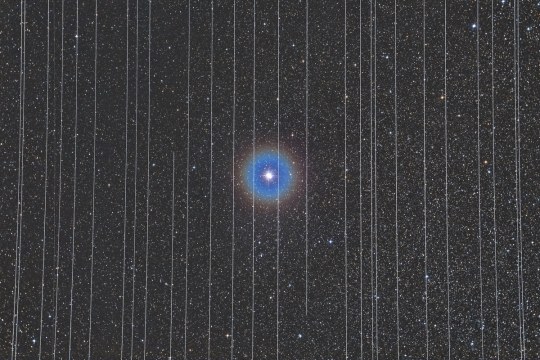
“The Prison of Technology” by Rafael Schmall (Hungary). People and Space, Winner.
The star in the center of the image is the Albireo double star, surrounded by the trails of moving satellites. How many more might there be by the time we reach next year’s competition? There could be thousands of moving dots in the sky. In order to create astrophotos, photographers have to carefully plan where to place the telescope, and this will be more difficult in the future with more satellites in the way.
Sky-Watcher Quattro 200/800 astrograph telescope (modified) at f/4, Sky-Watcher EQ6-Pro GOTO mount, Canon EOS 6D camera, ISO 1600, 5 x 150-second exposures.

“The Four Planets and the Moon” by Alice Fock Hang (Reunion), aged 11. Youth Competition, Winner.
Photographing a planetary alignment requires rigor and patience but also a lot of luck. That evening, despite preparing everything for a week, the photographer encountered clouds. The magic started after sunset, where the moonset, Venus, Mercury, the star Antares, Jupiter, and Saturn could be seen over the Indian Ocean. By looking at the sky map, The photographer could see that Pluto was there also above Saturn but invisible in my image. Note also the presence of Alpha Centuari on the left of the image as well as our immense galaxy, the Milky Way.
Nikon D610 camera, 35 mm f/3.2 lens, ISO 3200, 18 x 13-second exposures.

“Collision Course!” by Winslow Barnford (USA), aged 15. High Commended, Youth Competition.
This is an image of the Andromeda Galaxy (Messier 31) as well as two smaller galaxies (Messier 32 and Messier 110). The photographer started collecting data on this target in Sequoia National Park, on a dark-sky trip, however, due to technical failures he had to finish the image from his roof, under much heavier light pollution.
Meade Series 6000 70 mm f/5 APO Astrograph Quadruplet refractor telescope at f/5, Orion Atlas Pro mount, Nikon D5300 camera, ISO 400-1600, 3-hour total exposure.
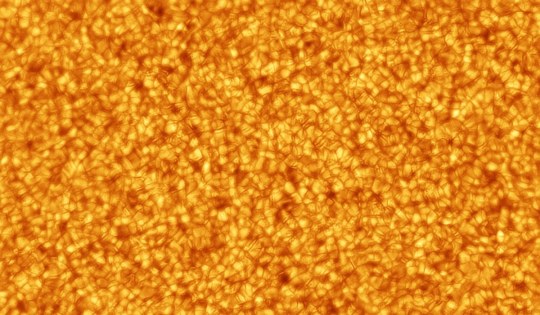
“Liquid Sunshine” by Alexandra Hart (UK). Our Sun, Winner.
Solar minimum may be seen as a quiet Sun and deemed dull in white light, but if you look closely at the small-scale structure, the surface is alive with motion. This surface is about 100 kilometers thick and the ever-boiling motion of these convection cells circulate, lasting for around 15 to 20 minutes. They are around 1,000 kilometes in size and create a beautiful ‘crazy paving’ structure for us to enjoy.
Celestron C11 XLT Schmidt-Cassegrain telescope at f/50, Baader Solar Continuum Filter with ND3.8 AstroSolar Film, Sky-Watcher EQ6 Pro mount, ZWO-ASI174MM camera, 8.431-millisecond exposure.
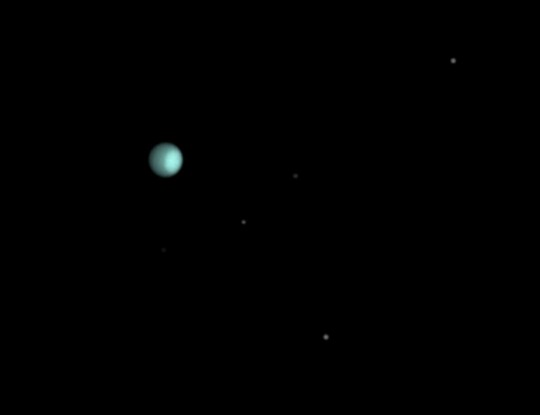
“The Outer Reaches” by Martin Lewis (UK). Planets, Comets, and Asteroids, Winner.
On 3 December 2019, the cloud cleared around mid-evening to reveal exceptionally steady skies over the photographer’s home in the UK. Making the most of the conditions, he turned his telescope to the distant planet Uranus and started gathering video frames using an infrared filter to bring out cloud details on this otherwise visually bland planet. To get the best images, a photographer must average the best of many short exposures. For an object as faint as Uranus, this means the individual frames are very noisy. That night, even through these noisy preview frames, the lighter polar region could be easily seen – a most exceptional situation and a testament to the steady skies that night.
https://mymodernmet.com/astronomy-photographer-of-the-year-2020/
Thank you😊❤️❤️❤️❤️
28 notes
·
View notes
Text
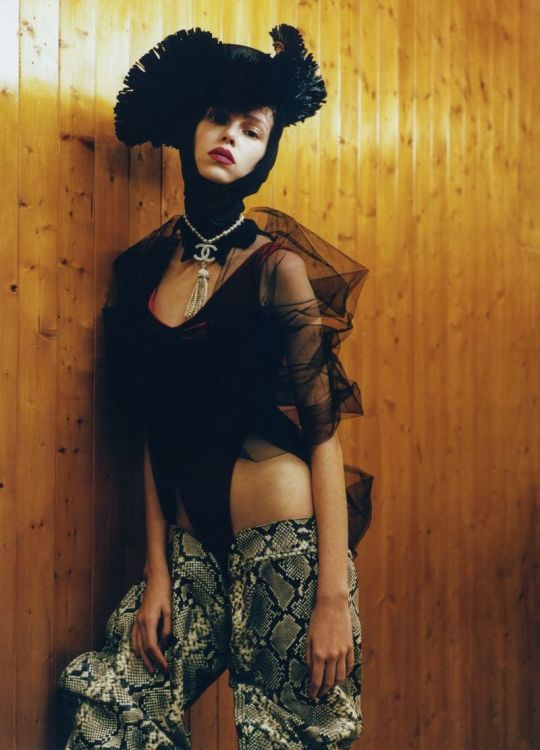
#Office#Office Magazine#Spring/Summer 2018#2018#Thurstan Redding#Anders Solvsten Thomsen#Louis Ghewy#Ciara O'Shea#Nicola Kast#Lorena Maraschi
12 notes
·
View notes
Video
vimeo
Jil Sander +J UNIQLO – FW2020
Editor – Richard Mettler
Director of Photography – Htat Htut
Original Score – Frédéric Sanchez
Choreographer – Emma Chadwick
Stylist – Sasha Kelley
Casting – Nicola Kast
Hair – Tamas Tuzes
Makeup – Karan Franjola
Manicurist – Naomi Yasuda
Colorist – Mike Howell
6 notes
·
View notes
Text
Helmut Lang Resort 22-23 Campaign
Helmut Lang Resort 22-23 Campaign
Helmut Lang Resort 22-23 CampaignSource: helmutlang.comPublished: December 2022
In this picture: Ebony Francisco, Sasha AshCredits for this picture: Hugo Comte (Photographer), Katie Burnett (Fashion Editor/Stylist), Orlando Pita (Hair Stylist), Allie Smith (Makeup Artist), Eric Mestman (Set Designer), Nicola Kast (Casting Director), Mei Kawajiri (Manicurist)
All people in this campaign:
Hugo…

View On WordPress
0 notes
Photo

JOANNA BAJENA (JoJo) for GARAGE MAGAZINE by LAUREL NAKADATE casting NICOLA KAST
#garage14#garagemagazine#editorial#JoJo#joanna bajena#Laurel Nakadate#Nicola Kast#Christopher Kane#snow#photography#art#postoftheday
0 notes
Photo

Jay Wright by Driu Crilly & Tiago Martel for Part Two: Sun Seekers Bon Magazine Spring/Summer 2017
#fashion editorial#fashion photography#bon magazine#spring summer 2017#jay wright#tiago martel#driu crilly#driu & tiago#julia ehrlich#ilker akyol#yumi lee#nicola kast
38 notes
·
View notes